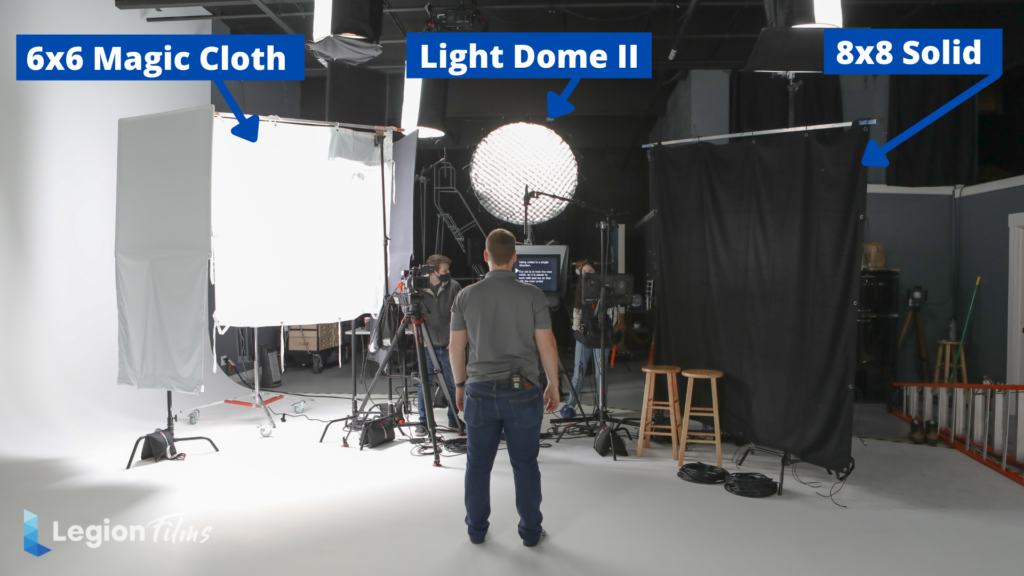The importance of lighting in video production can often be overlooked. It affects everything about the quality of your project, from its composition to how much detail you can see on your subject. Learning how to light a scene properly can be difficult, but it’s worth the effort if you want to produce videos that look great and tell a complete story.
Good lighting is essential in creating high-quality videos because it enhances your ability to tell a story. Not only can good lighting allow you to set the proper mood for your production, but scenes and sequences are more visually appealing, and certain areas and elements can be made more interesting, all because you have the right light.
Without proper lighting, it is difficult to capture certain types of scenes or create professional-looking videos. In this article, we’ll take a closer look at what lighting is, why it matters, and how you should use it in your next project.
The Basics: What is Lighting?
Lighting is the method used by filmmakers and photographers to create the effect of illumination on film or photographic media. It is a creative technique that involves using light sources selectively to achieve specific effects: creating shadows as a medium for storytelling and mood; playing with contrasts between light and dark; working with color temperatures; etc.
Through proper lighting, you can illuminate certain areas or elements in a way that makes them visually appealing or interesting. This can be achieved through high-quality lighting equipment, such as a professional camera light kit, but it’s also possible to achieve good lighting with just the use of natural light and some creativity.
Lighting is typically controlled by a person or automated light fixtures that allow you to choose different levels of brightness, including white balance, color temperature, and intensity. In addition to this control provided by the lighting fixture, there are also external sources of light you can use, like window lights or interior room lights.
The Types of Lighting in a Video Production
There are four main types of lighting: natural, artificial, diffused, and reflective.
- Natural lighting comes from the sun or the moon and is usually free of shadows.
- Artificial lighting is provided by a light source like a camera or computer screen.
- Diffused lighting occurs when a large surface such as a white wall or ceiling reflects all colors in the scene back at you.
- Reflected light does not create shadows but does provide illumination for your subject and creates highlights on their face or hair.
Without proper lighting, it is difficult to capture certain types of scenes or create professional-looking videos. In this article, we’ll take a closer look at what lighting is, why it matters, and how you should use it in your next project.
Key Lighting Tools in Video Production
Lighting is one of the most important aspects of video production. Here are a few key tools to use when you’re shooting:
- A light diffuser
- A light stand
- A light reflector
- A gel or diffusion filter
- A tripod and camera mount
- Softboxes, umbrellas, or scrims
How Does Lighting Affect a Video recording?
Lighting is a very intricate part of a production that is often overlooked. Lighting can help create a certain mood or a sense of drama or even create a sense of place. It can be used to make a video more visually appealing, or it can be used to help hide a bad background or a bad camera angle.
Whatever the case, lighting is very important to video production because it can help make a video look more professional and it can help tell a story.
Natural vs. Artificial Lighting
There are two lighting options for video recording: natural lighting and artificial lighting. Natural lighting is the lighting that comes from the sun, which produces a natural, warm light. Artificial lighting is the kind that we create for our videos.
Artificial lighting has many benefits, including the fact that you can control the intensity, direction, color, and shadows. If you don’t have the luxury of shooting in an environment with natural lighting, you can use artificial lighting to your advantage to create a high-quality video
How to Properly Light a Scene
This may seem like a simple question, but it’s actually a complex process. Lighting is one of the most important aspects of video production because it can make or break your footage. When considering how to properly light a scene, there are three things you should keep in mind.
First, you need to consider what type of scene you are shooting and for what purpose. Some scenes will require different lighting situations than others so it’s important that you know what kind of lighting best fits your project.
Second, when choosing the appropriate amount of light, it’s important to think about how much can be seen on camera. There are no hard-and-fast rules when it comes to this; different cameras have different capabilities and they often vary by lens as well. To ensure that your camera captures the most light possible and gets quality footage, ensure that the aperture is wide open or at its widest setting.
Third, be conscious about where your lights are placed and which direction they’re facing during filming. This will help determine how much shadowing is cast on surfaces and people in your scene and affect the overall quality of your video production.
How Do I Know I Have the Right Lighting for My Video Production?
There are many factors that go into lighting a scene, such as the time of day, the weather, and the lighting conditions for the scene. The lighting for your scene should match the mood. For example, a dark, moody scene would not be lit with bright fluorescent lighting.
There are two main lights that you will use in your video production: key light and fill light. The key light is the main light that is used to create the mood. In a situation where you are interviewing a subject, it is the light that is on the subject. The fill light is what can be described as the support light. It is the light that helps to create a contrast between the subject and the background. Headlights, streetlights, lamps, and candles are examples of fill light.
Best Practices for Lighting in Video Production
There are a few best practices that should be followed when it comes to lighting in your video production.
First, you’ll want to make sure the scene has enough light. This is important if you’re shooting indoors, where available light may not be enough. If you’re filming outdoors, make sure there’s plenty of natural light and avoid using reflective surfaces (like white walls) as they will create harsh shadows that can distort your video’s composition.
You’ll also want to use the right type of light for the situation. For example, if your subject is wearing dark clothes or sitting in a dark room, then you might want to use a hot light with bright white diffusion (to soften shadows). Hot lights produce lots of light and give you more options for adjusting the intensity of your color temperature as needed.
It’s also important to be aware of how much shadow coverage is on your subject. If there are large areas of shadow behind them in an otherwise well-lit shot, then it will be difficult for viewers to follow their actions and understand what they’re doing or why they’re doing it. To avoid this problem, take the time to scout out your scene before shooting so that you can position yourself properly and adjust the angle of the camera accordingly so that there’s no unnecessary shadow on your subject.
Finally, don’t forget about lens flare! Lens flare happens when bright lights hit a lens at certain angles and cause it to reflect brightly off of shiny surfaces like glass or water



